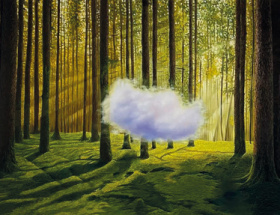Attractive Image, Transvestite Image
By Magaly Espinosa
The link between painting and third dimension is a
link of painting with the poetic power of words and fables.
Jacques Rancière
Postmodern procedures are employed to achieve this: pastiche, parody, deconstruction and intertextuality penetrate not only the morphology of the work in relation with advertising fetishes, mixtures of their images and values, screen captions and constant elements of fashion and comics, but also the meanings of reception context that make them possible. Philosopher Jacques Rancière has the following argument on it: “The destruction of the mimetic order does not mean that the arts have been doing “anything” since the 19th century, or that they dedicate themselves freely to the conquest of their own medium. A medium is not “one’s own” means or material. It is a surface for the change…”
The work of the young artist William Acosta borders the dangerous contemporary world of the image, and what at first sight may seem an ingenious game of advertising, images and urban subjects, beautiful forms and attractive glimpses of what is public, are in fact a theme of reflection on the life of our times.
The ability and dexterity with which the creator handles them according to their dissimilar origins make up his discourse, since it is not just a visual game or a harmonious composition, but the means through which that surface behaves as an image, containing, as pointed out by Rancière, articulations between “the forms of doing and some forms of visibility and intelligibility that determine the way in which they may be seen and thought…”
This search on the conversions brings to light the representations of superimposed, intertwined and mixed meanings, achieving a movement that approaches the painting event to its most constant opponents: photography and the cinematography.
His most recent series Autómata y Mentiras brillantes (Automat and Bright Lies) approach Ridley Scott’s Blade Runner or the Sense 8 series by the Wachovsky sisters. But the approaches are different in each case; the film images emerge from the whole composition, those of the series are more related to the presence and spirit of the characters, in which the individuality of each one of them is only possible through the existence of the group.
The characters William shows us are part of the urban atmosphere, as if they could not escape it and merge with the environment, somehow showing the uprooting that exists in all of them when you are only classified by the environment. In those cases when they appear facing backwards, the harmony of advertising has been violated, since this pose is neither obliging nor expresses satisfaction. On the contrary, the intention is to highlight their quality of bearers of the problems caused by the voracious life of the metropolis; they have thus become cultural codes that facilitate the meanings related with advertising and the market. As he states: “…we are conditioned by advertising… it creates disorder in your conscience and enslaves you.”
He sets the urban landscapes in different contexts, granting them a different image, another appearance, and thus creates a new city making use of the entire visual arsenal at our disposal. As in the last-mentioned series, he turns us into replicas of the forms of life, with the capacity to reproduce a common destiny through gestures, positions and forms of dressing up.
Formal mastery, harmony and balance appear in most works, but what distinguishes them is not only related to adequate formal solutions; it is the transformation into images of the simulated values that sustain the contemporary individual, which becomes evident in the indifference of a disoriented passer-by when the city is registered on his body and he has become a public object asking himself: what am I in midst of this confusion of lights, colors and noises in constant movement?
The cities have been displayed in many layers, but only in the painting do we see them in the same space, crowded with buildings, public spaces, traversed by cars and men as if both were the same thing.






